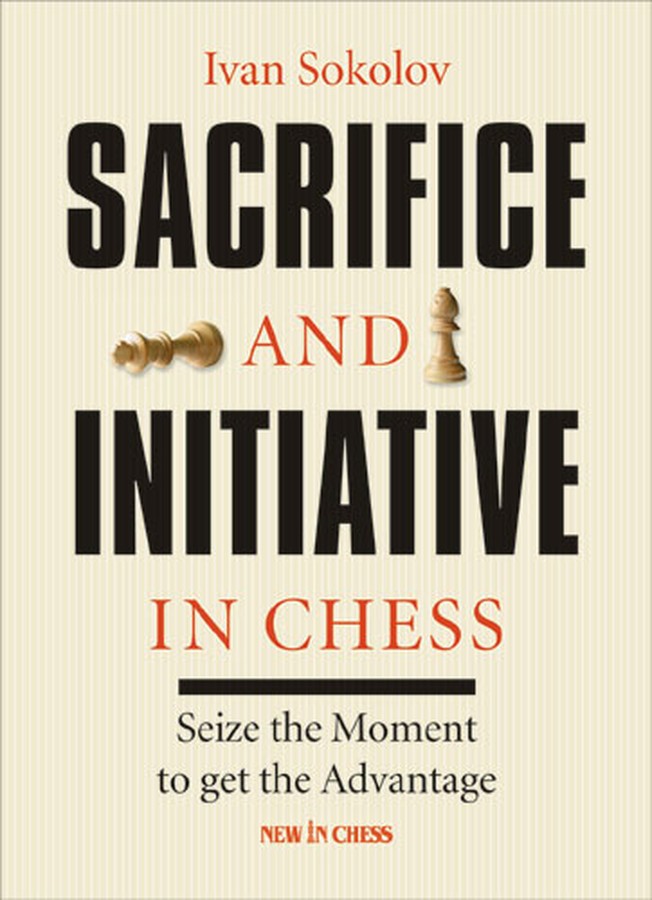| Nivå | C-D |
| Utgivelsesdato | August 2013 |
| Forfatter | |
| Pris | 310 NOK |
Sacrifice and Initiative in Chess
Seize the Moment to Get the AdvantageDet finnes etterhvert endel bøker om offer, intuisjon og angrepssjakk, men denne nye av den mangeårige verdensstjernen Ivan Sokolov fanger likevel stor interesse. Han har tydelig gjort et stort og engasjert arbeid, som det også framgår av forordet hans.
FORORD:
‘Sacrifice and Initiative’ is a book I have wanted to write for a long time. Though these are the two most important aspects of dynamic play, they have been largely ignored by chess authors and publishing houses and we still have very lit tle work published on the subject. Yes, we do have plenty of books dealing with tactical training, tactical motifs, combinations... but those are actually ‘shame sacrifices’, meaning that after a forced sequence of moves, the sacrificing side gets his material investment back with interest. On the subject of the ‘true sacrifice’, where the sacrificing side takes off on a journey, on a slippery road with no guarantees, still very little work has been published, and we often have to go as far back as Rudolf Spielmann or Vladimir Vukovic to find a good, structured work.
My work has taken me a long time. To reach a final decision on the selection of the games, I played through almost 1,000 games, from the old masters to the modern gladiators, in order to select 200 games for a ‘work database’. And out of this work database eventually came my final selection. The reader will quickly notice that the great majority of games are from the Tal period on wards – the ‘old masters’ are barely present. There is a reason for this. When I played through and analysed the old masters’ games, it quickly be came ob - vious that in the old days, the defenders simply did not defend well, so the attacker was usually not put to the u timate test to justify his material investments. After selecting the games, I had to classify them in a structure of attacking themes. First I made a separation between an ‘Initiative’ and a ‘Sacrifice’ part, and then a further division into separate attacking themes. But the reader has to understand that all those themes – well, 90% of them any how – are interwoven! It is very rare that a ‘true sacrifice’ game is won by using only one single motif. Usually a combi - nation of at least two different attacking themes is needed in order to win in an attack introduced by a ‘true sacrifice’.
For the theme selection and the book structure I have tried to combine common knowledge (since the days of Spielmann’s book ‘The Art of Sacrifice in Chess’, in Ger man Richtig opfern!) with modern practice and find a balance between the two. Before every chapter, the reader can find explanations of the theme at hand. Here, how ever, I will give a general set of ‘rules’ which can be universally applied to the theme of ‘sacrifice & initiative’: – taking over the initiative of ten means you have to ignore your opponent’s threat – when your opponent poses a threat, try to find a way to ignore it – an opponent’s threat can be ignored by posing a higher-de gree threat of your own – to get to your opponent’s king in the centre or a castled king, you need open files and diagonals, and you should often be ready to sacrifice to achieve this – removing the pawn defences in front of the enemy king is often essential, and frequently the only way to achieve this is with a piece sacrifice – in many cases an essential piece in the attack (in order to weave a mating net) is the knight! – a king chase is often difficult to calculate accurately until the end, but it mostly works for the attacking side – assessing the ratio of ‘attackers vs defenders’ (i.e., the forces in the attack as op - posed to the forces in the defence) is al ways a good way to get an idea if ‘some - thing can work’ – never recapture a piece immediately with out thinking, unless it is absolutely forced, as alternatives may offer surprising tactics – once you are on the at tack, never look back! – once you are on the at tack, do not think about the desired result – look for moves in stead! Thinking about the result during the game puts a ‘mental brake’ on the attacker – once you are swimming in the stream of the ‘sacrificing river’ – swim! Do not look for a life boat. The best attacking ideas take an effort and they take courage!
Writing this book has also helped me understand some of the great players better. Mikhail Tal’s sacrifices have a reputation that there was a significant amount of bluff involved, and before I started working on this book and had a serious look at his sacrifices, I was inclined to concur to this general opinion. But nothing could be further from the truth! Even if you give them enough time to run, computer engines are not able to refute 90% of Tal’s sacrifices. There is always compensation even against the very best defence, and most of the time it is enough for at least a draw.
Of course, I do not know, and I will never find out, how much of those possibilities Tal actually saw and how much of it was his ‘intuition’ (please see in the chapter on ‘Intuitive Sacrifices’ my opinion on this subject). But I’m sure he saw a lot! Tal was an attacking devil, a nine-headed monster, a true Houdini. Not that crap we buy for 80 eu ros and in stall on our computers – Tal was the real deal. He could hide an elephant!
David Bronstein had many original ideas, but in genuine attacking play, attacking geniuses like Tal and Spassky were head and probably also shoulders above him. There are also things I already knew that were confirmed by my work on this book: – the involvement of computer engines has killed part of Kasparov’s attacking genius – Spassky was a brilliant attacker, and every chess player is well advised to study his games – from the modern elite, the player who is the most inclined to take off on the slippery road of an intuitive sacrifice is probably Aronian.
Through out the book I have highlighted important tips with italics. These tips are repeated at the end of each chapter, so they will be easier to memorize. I hope that after reading this book, the reader will improve his attacking skills and recognize attacking patterns more easily. I also hope that the reader will en joy playing through the selected games, as much as I have enjoyed analysing them!
13 June 2013 Ivan Sokolov
| Innbundet? | Nei |
| Type | Bok |
| Språk | Engelsk |
| Antall sider | 255 |

